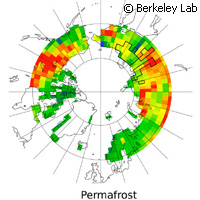Computer modelling shows release of carbon into atmosphere
A new international research study suggests that changes in the Earth's climate will trigger the release of billions of tonnes of carbon trapped in high-latitude permafrost into the Earth's atmosphere by the end of the 21st century. The study, presented in the Proceedings of the National Academy of Sciences (PNAS), reveals that this carbon release could in turn speed up global warming. The research was funded in part by the COMBINE ('Comprehensive modelling of the Earth system for better climate prediction and projection') project which has received almost EUR 8 million under the Environment Theme of the EU's Seventh Framework Programme (FP7). Using computer modelling at the French-based supercomputing facility Alternative Energies and Atomic Energy Commission, the researchers from Canada, France, the United Kingdom and the United States have also found that a warming of the soil could lead to soil in high-latitude regions changing from being a sink to a source of carbon dioxide (CO2). The team, headed by Charles Koven of the United States Department of Energy's Lawrence Berkeley National Laboratory (Berkeley Lab), says the results counter the findings from a comparison of models included in the Intergovernmental Panel on Climate Change's 2007 fourth assessment report. According to the researchers, the comparison found that climate change will stimulate growth in high-latitude vegetation, which will pull in more carbon from the atmosphere than thawing permafrost will release. However, this latest model includes detailed processes of how carbon builds up in high-latitude soil over time, and how it is released with the thawing of permafrost. These processes allowed the new model to start with a great deal more carbon in the soil compared to its predecessors, and provide insight into the carbon's vulnerability to decomposition as the soil warms. The team ran four simulations for the years ranging from 1860 to 2100, using a various assortment of processes for each. They also added a 'middle-of-the-road' climate change scenario that triggered an 8o Celsius jump by 2100, a temperature that is greater than the international average. Based on the model's findings, the boost in carbon uptake by more vegetation will be eclipsed by the bigger amount of carbon released into the atmosphere, the team says. 'Including permafrost processes turns out to be very important,' says Dr Koven. 'Previous models tended to dramatically underestimate the amount of soil carbon at high latitudes because they lacked the processes of how carbon builds up in soil. Our model starts off with more carbon in the soil, so there is much more to lose with global warming.' Working with his colleagues, Dr Koven estimated how much CO2 and methane could be released by boreal and Arctic land ecosystems because of climate change. The researchers say these ecosystems play an instrumental role in the global carbon cycle because they are rich in soil organic carbon that has built up in frozen soils and peat layers over the millennia. They point out that the majority of this carbon is currently trapped and not recycling. However, they add that some of it could be released as the climate warms. This could potentially be a positive feedback to global climate change. Meanwhile, the study also discovered a slight rise in methane release. 'People have this idea that permafrost thaw will release methane,' Dr Koven says. 'But whether carbon comes out as CO2 or methane is dependent on hydrology and other fine-scale processes that models have a poor ability to resolve. It's possible that warming at high latitudes leads to drying in many regions, and thus less methane emissions, and in fact this is what we found.' The researchers say more work must be carried out to increase our understanding of the processes that cause carbon to be released in permanently frozen, seasonally frozen and thawed soil layers.For more information, please visit:Berkeley Lab:http://www.lbl.gov/PNAS:http://www.pnas.org/
Countries
Canada, France, United Kingdom, United States



